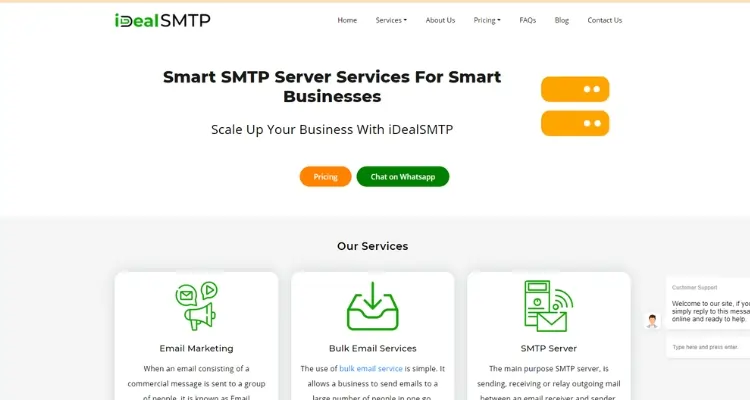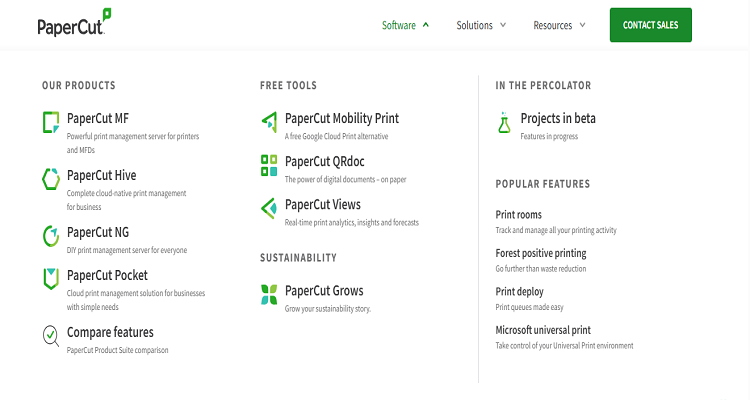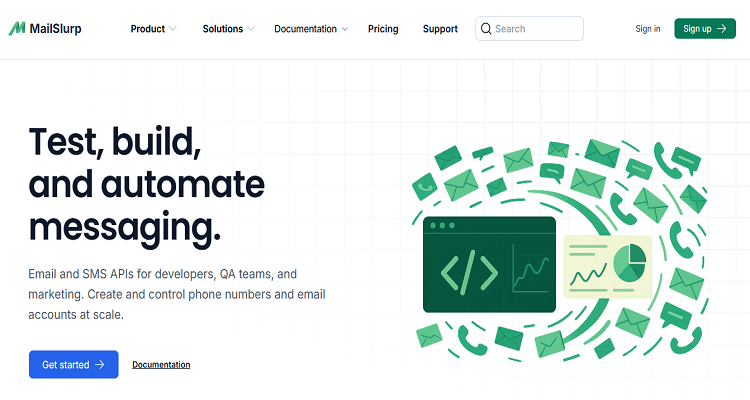Mailtrap Alternatives have become important because, while Mailtrap is reliable for sending, testing, and controlling emails, it sometimes lacks the integrations, user-friendliness, and bulk email sending features that many users need. As a result, developers and marketers are actively looking for the best Mailtrap alternatives that better fit their requirements in 2025.

In this blog, I will explore the top 5 Mailtrap competitors to help you choose the right email testing tool.
What Is Mailtrap?
Mailtrap is a tool used by developers to test outgoing emails during development. Instead of sending those emails to actual users, Mailtrap captures them in a safe “sandbox” inbox. This way, you can check the email’s content, design, and functionality before making it live.
For example, when your app sends a password reset email, you don’t want to send it to a real user while testing accidentally. By using Mailtrap SMTP settings, the email goes into your Mailtrap inbox instead.
How to Set Up Mailtrap SMTP?
Here are the basic SMTP settings for Mailtrap:
SMTP Host: smtp.mailtrap.io
Port: 2525
Username: [your Mailtrap username]
Password: [your Mailtrap password]
You enter these details into your app’s email configuration. Once done, all your test emails are redirected to your Mailtrap inbox safely.
Why Look for Mailtrap Alternatives?
Even though Mailtrap is widely used, it has some limitations. Here are the main reasons why developers search for a Mailtrap alternative:
- The free plan has limits on the number of test emails you can send.
- Paid plans may be expensive for small teams or personal projects.
- Mailtrap only works as a cloud service, so it needs internet access.
- There is no open-source or self-hosted version available.
- Some developers want more automation or better team collaboration features.
- They prefer a tool that offers a local setup to work offline.
If any of these sound familiar, it makes sense to explore other options.
Top 5 Mailtrap Alternatives You Should Know About
Here is a detailed list of the best tools you can use instead of Mailtrap. Each one has its strengths, so you can pick the one that fits your needs best.
1. SMTPmart
SMTPmart is one of the top alternatives to Mailtrap. It supports both SMTP and API email testing with a clean and simple interface. SMTPmart is designed to help you test emails quickly without any hassle. It’s a great choice if you want a full-featured tool that works well for teams and projects of all sizes. In addition to testing, it can also support bulk email workflows, making it useful for businesses that send large volumes of emails and want to ensure proper delivery and formatting.
It also allows you to preview emails before they are sent, helping you catch errors in content, design, or links. This ensures your emails look professional and work correctly across different devices and email clients. SMTPmart makes it easy to share test results with your team, which improves collaboration during development or marketing campaigns.

Features for SMTPmart:
- Quick and easy SMTP setup
- Real-time inbox with full email preview (HTML and plain text)
- Spam score checking and link validation
- Supports multiple inboxes for different projects or teams
- Detailed email header and metadata view
Pros:
- User-friendly UI even for non-tech users.
- Supports bulk email simulation.
- Great for marketing and transactional email testing alike.
- Team collaboration features are built in.
Best for: Developers and teams who want a powerful yet easy-to-use email testing tool.
2. iDealSMTP
iDealSMTP is also an alternative to Mailtrap, and it offers a smart and scalable email testing platform ideal for developers working on larger projects or with growing teams. iDealSMTP stands out by offering detailed analytics and team collaboration features, making it great for projects that need more control over email testing.
The platform supports easy integration with popular development tools and frameworks, helping teams save time and reduce errors during the testing process. You can manage multiple projects and users in one place, which keeps everything organized and efficient. iDealSMTP also provides real-time notifications about email delivery and possible issues, so your team can act quickly to fix problems.

Features for iDealSMTP:
- Fast SMTP integration with any app
- Real-time inbox with filtering and tagging options
- Detailed tracking and error reporting
- API and webhook support for automation
- Great for staging and production environments
Pros:
- Rich analytics and error tracking.
- Ideal for email automated testing with CI/CD pipelines.
- Supports multi-user environments.
- Advanced documentation and developer support.
Best for: Teams and businesses that want advanced testing and tracking features.
3. Papercut SMTP
Papercut SMTP is a desktop app that works on Windows and macOS. It captures emails sent from your local apps and displays them in an easy-to-use desktop window. If you prefer a desktop app over browser-based tools, Papercut SMTP is a solid choice.
It’s especially useful for developers who want to test emails without actually sending them to real recipients. You can quickly see how your emails look and make changes before going live. Since it runs locally on your computer, there’s no need for an internet connection to test your emails, which makes it fast and reliable.

Features for Papercut SMTP:
- Easy installation and use on a desktop
- Catches SMTP server emails sent to localhost
- No internet connection needed
- Simple interface to read and save emails
Pros:
- Offline-friendly – Perfect for travel or low-connectivity environments.
- No signup or login required.
- Ideal for developers who want quick, no-fuss testing.
Cons:
- Not designed for team use or cloud integration.
- Lacks advanced analytics or preview tools.
Best for: Developers who want a simple desktop email testing app.
4. DigitalAka
DigitalAka is also a Mailtrap competitor & alternative and a fast tool made for developers focused on email design and delivery accuracy. It offers real-time email testing, clean inbox previews and detailed analytics to help developers fine-tune their email campaigns. DigitalAka supports team collaboration features, making it easier for multiple users to work together and ensure every email looks perfect before it reaches your audience.

Features for DigitalAka:
- Simple SMTP setup
- Full preview of HTML and plain text emails
- Mobile and desktop views for email testing
- Checks for broken links and spam scores
- Team inboxes for collaboration
Pros:
- Excellent UI/UX for designers and QA testers.
- Collaboration and comment features are built in.
- Strong focus on email aesthetics.
Cons:
- Not ideal for advanced automation workflows.
Best for: Frontend developers and teams focused on email design and quality.
5. MailSlurp
MailSlurp is great for developers who want to automate email testing using code. It offers inbox creation and management via API. If you need to automate email workflows or build integration tests, MailSlurp is a great pick. It allows you to easily generate temporary email addresses for testing purposes, helping you simulate real-world scenarios without cluttering your own inbox.
With detailed logs and webhook support, you can track every email event and trigger actions based on what happens in your tests. This makes it a powerful tool for continuous integration and delivery pipelines. Whether you’re testing sign-ups, password resets, or complex email flows, MailSlurp helps save time and reduces manual work, making your development process smoother and more reliable.

Features for MailSlurp:
- Create and manage test inboxes programmatically
- Supports multiple programming languages
- Allows sending, receiving, and reading emails via API
- Useful for automated tests and CI pipelines
Pros:
- Ideal for test automation and integration testing.
- Scales well with large test suites.
- Useful in QA environments with dynamic inbox needs.
Cons:
- Learning curve for beginners.
- Less suited to manual testing or non-developer users.
Best for: Developers needing automated and API-driven email testing.
How to Choose the Right Mailtrap Alternative?
To choose the best Mailtrap alternative, ask yourself:
- Do you want a cloud-based tool or a local tool?
- Is having an open-source tool important to you?
- Will you test emails manually or automate with APIs?
- Do you need a tool that supports teams and collaboration?
- What is your budget? Do you want a free or paid service?
- How important is a user-friendly interface versus a minimal tool?
If you want a powerful cloud service with many features, SMTPmart or iDealSMTP are great. For local and free options, try MailHog or MailPit. If you prefer desktop apps, use Papercut SMTP. For API automation, choose MailSlurp.
Final Thought
Testing emails before they reach real users is a vital part of app development. Mailtrap is popular, but not the only option. There are many excellent Mailtrap alternatives available that suit different needs.
Try out one or more of these tools and see which one fits your workflow best. Many have free plans or are open source, so you can get started right away.
If you need help setting up or choosing the best tool for your project, feel free to ask!
FAQs
Here are some of the frequently asked questions about Mailtrap Alternatives:
The best Mailtrap alternatives in 2025 include SMTPmart, iDealSMTP, Papercut SMTP, DigitalAka and MailSlurp. Each offers different features like cloud testing, local setup, automation, or open-source access to meet varied development needs.
Developers often seek Mailtrap competitors due to limitations such as restricted free plans, lack of offline access, no open-source version, and the need for more team collaboration, automation, or advanced analytics.
Yes, SMTPmart is the best alternative to Mailtrap. It supports fast SMTP setup, real-time email previews, spam checks, and is ideal for both solo developers and teams who need an all-in-one testing platform.
Papercut SMTP is excellent for local email testing. They don’t require internet access, are easy to install, and allow developers to view test emails right on their local machines.
Yes, tools like Mailpit are free and open source. These tools are perfect for developers who want local testing without depending on paid cloud services.
iDealSMTP and MailSlurp offer strong API and automation features. They allow developers to create inboxes, send, receive, and verify emails directly through their code or CI/CD pipelines.
To choose the best alternative, consider your project size, whether you prefer local or cloud tools, if you need team features or API support, your budget, and whether open-source is a priority. Tools like SMTPmart are great for full-featured testing.

